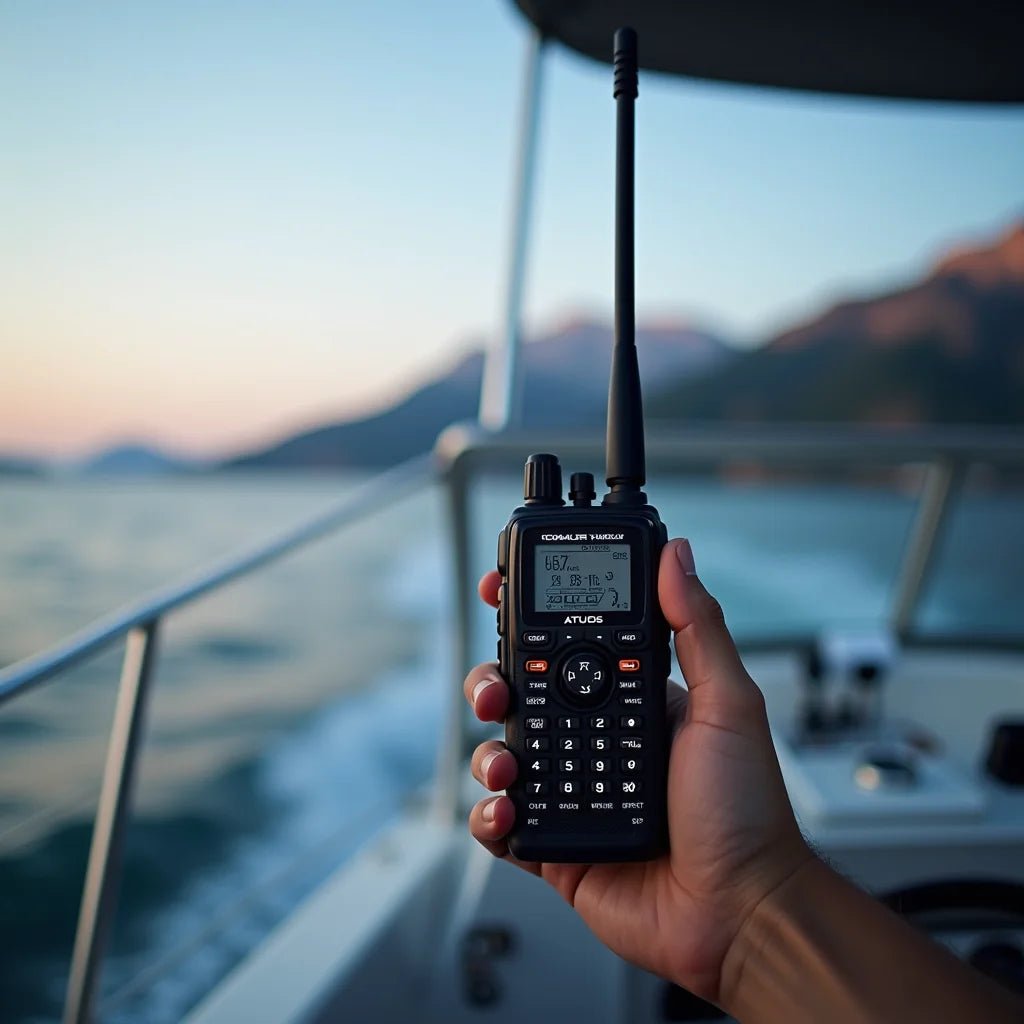Updated on: 2025-10-05
Table of Contents
- Why a Marine Handheld Radio Matters on the Water
- Essential Tips for Choosing a Marine Handheld Radio
- Detailed Step-by-Step Process to Set Up a Marine Handheld Radio
- Step 1: Charge and Inspect
- Step 2: Program Channels and Names
- Step 3: Set Your MMSI and Enable DSC
- Step 4: Test Transmit and Receive
- Step 5: Pair Bluetooth and Confirm GPS
- Step 6: Waterproof Check and Float Test
- Handheld vs. Fixed-Mount Marine Radio
- DSC Marine Radio: Safety and Etiquette
- Summary & Takeaway on Marine Handheld Radios
- Answers to Common Marine Handheld Radio Questions
Why a Marine Handheld Radio Matters on the Water
A marine handheld radio is a dependable communication tool for boaters, paddlers, and anglers who value safety and clarity on the water. Unlike mobile phones, a handheld VHF marine radio connects to nearby vessels and the Coast Guard on dedicated channels designed for maritime use. When conditions change or you need assistance, clear VHF communication can help everyone stay coordinated and calm.
If you are exploring local waters, you may find it helpful to keep up with community insights and conditions. For local updates and guides, you are welcome to visit Clinch River Fishing USA. This guide will help you select a portable marine VHF radio that matches your needs, set it up step-by-step, and use it with confidence and courtesy.
Essential Tips for Choosing a Marine Handheld Radio
- Prioritize waterproof and floating designs: A best floating waterproof marine handheld radio with GPS can add peace of mind if your radio goes overboard. Look for IPX7 or higher water resistance and bright colors that are easy to spot.
- Consider power and battery life: A typical portable marine VHF radio offers 5–6 watts. A higher watt rating can support clearer transmissions in open water, while a long-lasting battery and a rapid charger help on longer days.
- Check for GPS and DSC: GPS provides location data for navigation and may enable advanced features. A DSC marine radio can send a distress alert with your identity and location once you program your MMSI, which may help responders find you faster.
- Evaluate audio clarity and noise reduction: Loud, crisp audio helps when engines, wind, or waves create noise. A noise-canceling microphone can make your voice clearer to others.
- Review channel support and weather: Access to weather alerts and all standard VHF channels is helpful. Quick Channel 16 access is essential for hailing and distress.
- Look for useful extras: Some models provide Bluetooth, allowing hands-free use or connection to apps. A long-range marine handheld VHF radio with DSC and Bluetooth may support better coordination with your devices and crew.
- Think about ergonomics: If you wear gloves, large buttons and a textured grip can make a difference. A readable display with backlighting helps at dawn and dusk.
- Compare with a fixed-mount marine radio: Handhelds are portable and ideal for small craft or as a backup. A fixed-mount marine radio often has higher power, a bigger antenna, and consistent power from your boat, which can improve reach and audio strength.
- Confirm accessories: Belt clips, lanyards, and optional external mics can make daily use simpler. A spare battery or 12V adapter can also be helpful.
- Check for local guidance: If you are unsure about regional practices or popular gear in your area, reading a current blog or speaking with experienced boaters can be encouraging.
Detailed Step-by-Step Process to Set Up a Marine Handheld Radio
Step 1: Charge and Inspect
Charge the battery to full before first use. While it charges, inspect the gaskets, antenna, and battery door for a snug, even fit. A good seal helps maintain waterproofing.
Step 2: Program Channels and Names
Review your manual to set channel banks for your area. Program any group names or private channels you plan to use with your crew, and enable quick access to Channel 16 for hailing and emergencies.
Step 3: Set Your MMSI and Enable DSC
If your handheld supports DSC, request an MMSI (Maritime Mobile Service Identity) through an authorized provider and enter it carefully. Enable DSC features such as position polling if available. A DSC marine radio can send a distress alert that includes your identity and position when set up correctly.
Step 4: Test Transmit and Receive
Perform a simple radio check with a nearby vessel or a marina station. Keep your language brief and clear. If you have both a handheld and a fixed-mount marine radio, test each to understand differences in audio and reach from your usual operating area.
Step 5: Pair Bluetooth and Confirm GPS
If your radio includes Bluetooth, pair it with your compatible device for hands-free operation or logging. Check the GPS screen to verify it has a location fix. Some models allow you to share your position with your group, which can make coordination more comfortable.
Step 6: Waterproof Check and Float Test
With care, perform a quick float test in shallow, safe water to ensure your radio floats as designed. Confirm that the screen and keys remain usable afterward, and wipe it dry.
Handheld vs. Fixed-Mount Marine Radio
Many boaters wonder whether a marine handheld radio is enough or if a fixed-mount marine radio is the better choice. Each option offers distinct advantages that may suit different boats and styles of boating.
- Power and antenna: A fixed-mount typically transmits at higher power and uses a larger external antenna, which can improve coverage. A handheld is convenient and portable, with all-in-one design for tenders, kayaks, or as a backup.
- Battery and endurance: Fixed-mount units draw from the boat’s electrical system, so they can often operate longer and louder. Handhelds rely on batteries; carrying a spare or a 12V charger supports longer outings.
- Waterproofing and mobility: A handheld VHF marine radio that floats is handy because it can stay with the person, not just the vessel. This is reassuring during docking, paddling, or when moving between boats.
- Installation effort: Handhelds require no permanent installation. Fixed-mount units take more planning but reward you with strong audio, a dedicated mic, and a robust antenna system.
Many boaters choose both: a fixed-mount for primary communication and a portable marine VHF radio as a backup. If you would like to talk through what might suit your style of fishing or boating, the Contact page is available for friendly questions.
DSC Marine Radio: Safety and Etiquette
Digital Selective Calling (DSC) adds helpful safety and calling functions to VHF. When you press the distress button on a DSC marine radio, it can transmit your identity and position to nearby DSC-equipped radios and rescue services. This may improve the speed and clarity of response.
- Keep Channel 16 clear: Use it for hailing, safety, and distress. After contact, move to a working channel for further conversation.
- Use plain language: Speak slowly and clearly. Avoid jargon unless you are certain everyone understands.
- Be concise and courteous: State the name of your vessel, your location, and your need. Short, respectful communication helps everyone.
- Update your MMSI info: If you change boats or contact details, keep your MMSI record up to date, so responders have the correct information.
- Practice without cluttering the air: Coordinate quick tests during quiet times, and keep them brief.
If you are interested in how local anglers communicate during trips or tournaments, you may find background and stories on the About page insightful.
Summary & Takeaway on Marine Handheld Radios
A marine handheld radio is a practical, portable tool that supports safety and coordination on the water. For many boaters, a handheld VHF marine radio with GPS and DSC offers an accessible balance of features and ease of use. Handhelds excel as primary radios for small craft and as dependable backups for larger vessels with fixed-mount systems.
When choosing a portable marine VHF radio, focus on waterproofing, floating design, battery life, and clarity. Consider advanced features like Bluetooth and GPS if you value connectivity and location sharing. If you regularly travel offshore or want maximum transmit power and audio strength, a fixed-mount marine radio paired with a handheld can provide a thoughtful, layered approach.
With a little setup—charging, programming channels, enabling DSC, and testing—you can carry a clear, reliable voice on the water. If you enjoy learning from local experiences, you might appreciate reading the latest helpful notes on the community Blog as you refine your radio skills.
Answers to Common Marine Handheld Radio Questions
What is the range of a marine handheld radio?
Range depends on several factors, including antenna height, terrain, and weather. Over open water with a clear line of sight, many handhelds can communicate several miles, often around 3–8 miles between two handheld units. When one station uses a taller antenna (such as a base station or a fixed-mount marine radio), the effective range may increase. For practical planning, keep expectations modest and rely on line of sight rather than promised “maximum” distances.
Do I need a license to use a marine handheld VHF radio?
In many places, recreational boaters can use a handheld VHF without an individual operator license when operating domestically. Requirements can vary by region and by the nature of your vessel’s operations. If you travel internationally, or if your vessel is commercial, licensing and station requirements may apply. For the most accurate guidance, checking current information from your national communications authority is recommended.
Should I choose a handheld or a fixed-mount marine radio?
It depends on the size of your boat, your typical trips, and your comfort. A handheld is portable, easy to store, and great for small craft or as a backup. A fixed-mount marine radio offers higher power, a larger antenna, and robust audio, which can help when covering more distance. Many boaters keep both: a fixed-mount as the primary and a handheld as a flexible spare for on-deck tasks or shore runs.
Which features matter in the best floating waterproof handheld with GPS?
Look for floating design, IPX7 (or better) waterproof rating, long battery life, and a bright display that is readable in direct sun. Built-in GPS supports location sharing and DSC functions. If you value connectivity, a long-range marine handheld VHF radio with DSC and Bluetooth may make calling and logging easier. A loudspeaker with noise reduction, dedicated Channel 16 access, and clear menu navigation also improve daily use.

Owner and CEO of Clinch River FIshing USA. A marine electroncs, fishing and outdoor store.

